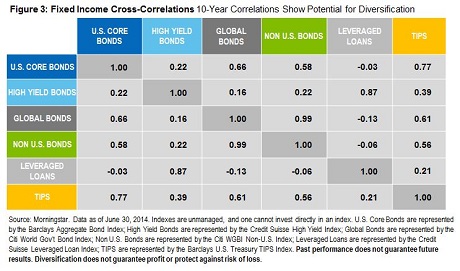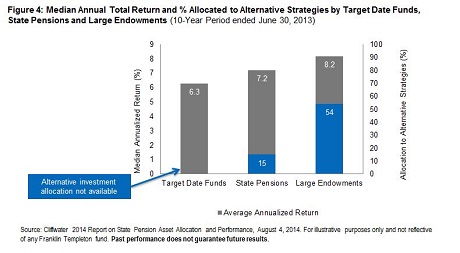However, the data shows that DC plan performance has persistently lagged that of institutional investment portfolios (endowments, state pensions and other defined benefit (DB) plans). For example, data from Towers Watson shows that DB plans have outperformed DC plans in 12 of the past 17 years (from 1995 to 2011), and by an average of 76 bps annually.[1] This differential may seem insignificant, but over a 40-year working career, the impact amounts to a 35% reduction in the participant’s future account value (i.e., what could be the difference between meeting retirement goals and missing the mark).
A potential explanation for the performance disparity is that large pools of institutional capital often utilize a wider variety of sophisticated strategies than most DC plans. Above and beyond the difference in fees, we argue that strategy selection plays a much larger role, particularly when considering the broad universe of assets generally available within institutional investment portfolios, including alternative investments, high-yield bonds and global equity and fixed income, all of which can offer the opportunity to improve diversification[2], capture alpha, and smooth bouts of market volatility.
If institutional portfolios have historically delivered better outcomes in part through exposure to a broader, more diverse asset mix, how can we justify restricting DC participant investment into an a narrower subset of the investable universe? Shouldn’t participants have access to the same investment opportunities as institutional investors?
We argue that traditional DC investment menus need to add new courses that provide a taste of global diversification and an expanded palate of strategies. Diversified multi-asset mutual funds as well as white-label investment options that draw on the expertise of multiple underlying investment managers are solutions for such diversification among strategies that may be able to take a bite out of the performance dichotomy.
Stone-Age Tools
The typical DC plan today still uses what we refer to as “stone-age” tools, the same tools we’ve been using for the past 20 or 30 years.
When DC plans were first introduced as participant-directed supplemental savings plans, there was a focus on protecting participants from bad decisions and, as a result, investment selection eschewed so-called “exotic” asset classes.
[1] Towers Watson, “DB Versus DC Investment Returns: The 2009 – 2011 Update,” May 2013. Past performance does not guarantee future results.
[2] Diversification does not guarantee profit nor protect against risk of loss.
In addition, as DC plans have evolved into the primary retirement savings vehicle, higher returns have also become increasingly crucial.
Much has been said about equity diversification in portfolios; DC plan lineups now offer numerous equity investment options. However, the lowest recent 10-year cross correlation is between small cap and emerging market stocks at 0.75 (Figure 2).

On the other hand, fixed income correlations for the same period are lower, with even some negative correlations (Figure 3), suggesting that additional diversification may be more effective.

Think Globally, Act Globally
According to a recent Franklin Templeton survey, U.S. investors tend to exhibit a “home-country” bias when it comes to equity and especially fixed income allocations.[1] Is this always wise? Are plan sponsors promulgating this bias in their investment lineups? Home-country bias can mean missing out on the possibility of improved portfolio diversification—and potential retirement outcomes—when U.S. markets underperform. Global diversification may provide a greater ability to weather market downturns within specific asset classes and across regional markets, with less potential portfolio volatility.
Alternatives: The Next Course
Half of today’s 401(k) assets are in plans with more than $750M in assets under management (AUM)[2]; however, those assets are usually not invested the way we would expect near-billion dollar pools of capital to be allocated. While some endowments and foundations have allocated to alternative investments, we believe DC plans typically have taken a more traditional approach.
According to Cliffwater research, institutional portfolios generally make more significant allocations to alternative investments and likely have benefitted as a result, outpacing the performance of DC assets. Historically, large pension plans and endowments have allocated 15% and 54% to alternatives respectively, a category that includes distressed debt, private equity, commodities and hedge funds.5

While every plan sponsor balances many risk/reward considerations, we believe that by adding alternative investments, DC plan participants can potentially benefit from added diversification and enhanced alpha opportunities. Additional advantages can include lower levels of volatility and correlation when compared to traditional asset classes.

[1] Source: Franklin Templeton Investments 2014 Global Investor Sentiment Survey. The survey was conducted online by ORC International in January 2014 and polled 11,113 investors across 22 countries.
[2] Source: ICI Research Perspective, Investment Company Institute, December 2013.
5 Source: NACUBO Commonfund Study of Endowments, 2012. Most recent data available.
Passive Aggression
In addition to asset class limitations within DC plans, we believe the quality of investment thinking has generally been constrained by overly simplistic approaches with respect to the merits of active management. Typically, DC plans approach the active versus passive decision as a binary choice. Should we make everything passive or do we go completely active? Of course, these decisions are not mutually exclusive and sponsors should focus on creating the best potential investment outcomes net of fees.
Institutional portfolios are typically constructed around their investment principles – e.g., high conviction asset classes use more of the active risk budget while low conviction asset classes utilize passive investments to reduce overall portfolio fees. The conversation is not generally an either/or proposition; rather, both can, and do have a place. Within active portfolios, managers can express and implement high conviction views to provide a potential source of alpha that index funds generally do not afford.
Closing the Gap
We acknowledge that allowing participants to construct their own portfolios with sophisticated asset classes can be akin to running with scissors. But just because an asset class is a part of the traditional toolkit does not always make it inherently safer.
We believe that diversified global, alternative, and multi-sector fixed income investment strategies are worth further consideration. While it’s true that, given the rise of automatic enrollment, many participants are already being defaulted into diversified multi-asset investment options, we believe that plan sponsors can offer improved diversification by using target date mutual funds that provide exposure to an even wider array of asset classes or by constructing their own white-label investment options that draw on the expertise of multiple underlying investment managers. This can be achieved without providing unfettered exposure to exotic asset classes.
With the right combination of tools, including looking beyond traditional asset classes, we believe we can build better retirement outcomes. As an industry, we need to think about what participants actually need in terms of retirement income and help them effectively transition into retirement. Our next article will explore solutions to help participants gain more control over this transition and increasing the likelihood of securing better retirement outcomes.
Authors:
Drew Carrington, senior vice president, head of Institutional Defined Contribution in the U.S. for North America Advisory Services for Franklin Templeton Investments
Yaqub Ahmed, senior vice president and head of Investment-Only Division-U.S. for North America Advisory Services for Franklin Templeton Investments
Michael Doshier, vice president of Retirement Marketing for Franklin Templeton Investments
NOTE: This feature is designed to provide general information only, and is intended for institutional investors. It does not constitute legal advice, or investment recommendations and it cannot be used or substituted for specific legal, investment, or tax advice. Any opinions of the author(s) do not necessarily reflect the stance of Asset International or its affiliates. Statements of fact come from sources considered reliable, but no representation is made as to their accuracy, completeness, or timeliness; nor is it a complete analysis of any asset class or strategy.
Franklin Templeton Distributors, Inc., is a wholly owned subsidiary of Franklin Resources, Inc. [NYSE:BEN], a global investment management organization operating as Franklin Templeton Investments.
Note that alternative investments such as unregistered hedge funds, private equity and real estate investments are typically more speculative in nature as they employ more complex trading strategies entailing additional, unique risks and considerations, including but not limited to hedging and leveraging through use of derivatives and short selling, illiquid investments and less regulation than mutual funds. Target date funds, in contrast, are publicly offered, SEC-registered mutual funds that typically hold more traditional investments and allocate to such over a predetermined period to reflect investors' changing tolerance for risk, generally adjusting the asset mix from more aggressive investments early in the life of the fund to more conservative investments as the investors approach their targeted date.You Might Also Like:
PLANSPONSOR Roadmap: SECURE 2.0 GPS
Retirement Contribution Limits, COLA Stay on Track With Continuing Resolution
Plan Sponsors Push Toward Retirement Income, Financial Wellness Over Last Decade
« (b)lines Ask the Experts – Should Fund Prospectuses Be Automatically Sent?

